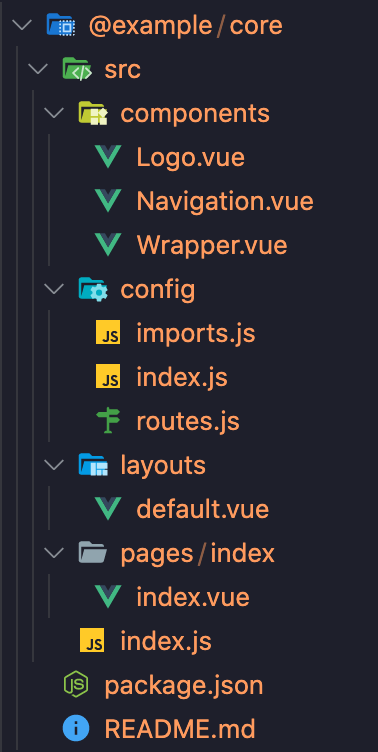Core module
The Core module will supervise every other module.
All files to be added are located in the
srcdirectory.

Initiate file
First you need to create an initialization file.
export default async function () {}
The function is empty because we do not run any additional mechanisms before this module.
Configuration
We create a config directory and in it we create an index.js file that contains all the configurations.
More information about configuration.
name
Set the name of the module. The name should match the directory structure.
name: '@example/core',
order
Specify the order in which the module is loaded. The smaller the value, the earlier the module is loaded.
order: 10,
aliases
Specifies the alias to refer to in other modules. It is needed for easy communication between modules
aliases: {
'@Core': '/',
},
Example:
export default {
name: '@example/core',
order: 10,
aliases: {
'@Core': '/',
},
}
Register module
After creating the module, we now need to add it to the VueMS configuration.
Registration is done in the VueMS configuration in the nuxt.config.js file.
We add the name of our module in the modules property.
Our first module is a required module, so we also add the module name to the required property.
export default {
vuems: {
modules: {
local: ['@example/core'],
},
required: ['@example/core'],
logLoadedModules: true,
},
}
Component
Create the first components in components directory.
Logo.vue
Create a Logo.vue file in component directory.
I am not presenting a full example of the Logo.vue component because it contains the svg file content.
If you want to see the full content of the component, you can find it in the repository.
<template>
<svg> ... </svg>
</template>
<script>
export default {
name: 'Logo',
}
</script>
<style>
.VuemsLogo {
animation: 1s appear;
margin: auto;
width: 300px;
}
@keyframes appear {
0% {
opacity: 0;
}
}
</style>
Wrapper.vue
Create a Wrapper.vue file in component directory.
The component will wrap other components.
<template>
<div class="wrapper">
<Logo />
<slot />
</div>
</template>
<script>
import Logo from '@Core/components/Logo'
export default {
name: 'Wrapper',
components: {
Logo,
},
}
</script>
<style>
.wrapper {
margin: 0 auto;
display: grid;
justify-content: center;
align-items: center;
text-align: center;
}
</style>
Navigation.vue
Create a Navigation.vue file in component directory.
The component will be used in the layout component.
<template>
<nav class="navigation">
<ul>
<li><NuxtLink class="button--green" to="/">Home page</NuxtLink></li>
<li><NuxtLink class="button--grey" to="/about">About</NuxtLink></li>
</ul>
</nav>
</template>
<script>
export default {
name: 'Navigation',
}
</script>
<style>
.button--green {
display: inline-block;
border-radius: 4px;
border: 1px solid #3b8070;
color: #3b8070;
text-decoration: none;
padding: 10px 30px;
}
.button--green:hover {
color: #fff;
background-color: #3b8070;
}
.button--grey {
display: inline-block;
border-radius: 4px;
border: 1px solid #35495e;
color: #35495e;
text-decoration: none;
padding: 10px 30px;
margin-left: 15px;
}
.button--grey:hover {
color: #fff;
background-color: #35495e;
}
.navigation {
position: absolute;
padding-top: 15px;
}
.navigation ul {
list-style: none;
display: flex;
flex-direction: row;
}
</style>
Page
The next thing is to add a new page.
We create a pages directory where we add the page.
In the new page component, we add our previously created Wrapper component.
<template>
<Wrapper>
<h1 class="title">VueMS-demo</h1>
</Wrapper>
</template>
<script>
import Wrapper from '@Core/components/Wrapper'
export default {
name: 'IndexPage',
components: {
Wrapper,
},
}
</script>
<style>
.title {
font-family: 'Quicksand', 'Source Sans Pro', -apple-system, BlinkMacSystemFont,
'Segoe UI', Roboto, 'Helvetica Neue', Arial, sans-serif;
display: block;
font-weight: 300;
font-size: 100px;
color: #35495e;
letter-spacing: 1px;
}
</style>
Router
For the page we created in the previous step to work, we need to add routing to it.
To do this we add the routes.js file in the config directory.
More information here
import { Pages } from './imports'
export const ROUTE_NAME = {
INDEX: 'index',
}
export default [
{
name: ROUTE_NAME.INDEX,
path: '/',
component: Pages.Index,
},
]
To keep things organized, we add a helper file for importing components.
In the config directory, add the imports.js file.
export const Pages = {
Index: () => import('@Core/pages/index').then((m) => m.default || m),
}
Layout
To give the module control over the layout and not to interfere with a file outside the module: layouts/default.vue.
It is best to create a layout wrapper that will be maintained in one of the modules.
In the @Core module, add the layouts directory and create the default.vue layout wrapper there.
<template>
<div class="main">
<Navigation />
<slot />
</div>
</template>
<script>
export default {
name: 'DefaultLayout',
components: {
Navigation: () => import('@Core/components/Navigation'),
},
}
</script>
<style>
html {
font-family: 'Source Sans Pro', -apple-system, BlinkMacSystemFont, 'Segoe UI',
Roboto, 'Helvetica Neue', Arial, sans-serif;
font-size: 16px;
word-spacing: 1px;
-ms-text-size-adjust: 100%;
-webkit-text-size-adjust: 100%;
-moz-osx-font-smoothing: grayscale;
-webkit-font-smoothing: antialiased;
box-sizing: border-box;
}
*,
*::before,
*::after {
box-sizing: border-box;
margin: 0;
}
</style>
Use layout component
We use the layout component in the nuxt layout file: layouts/default.vue.
<template>
<DefaultLayout>
<Nuxt />
</DefaultLayout>
</template>
<script>
import DefaultLayout from '@Core/layouts/default'
export default {
name: 'NuxtDefaultLayout',
components: {
DefaultLayout,
},
}
</script>